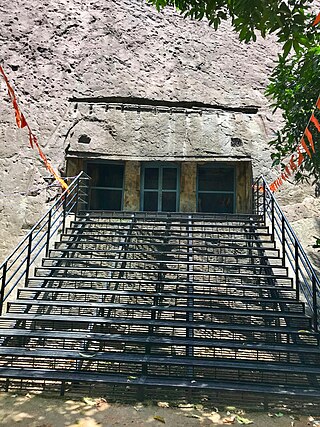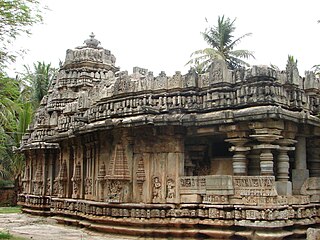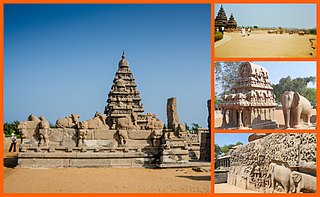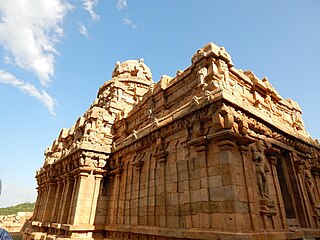
Pattadakal, also called Raktapura, is a complex of 7th and 8th century CE Hindu and Jain temples in northern Karnataka, India. Located on the west bank of the Malaprabha River in Bagalkot district, this UNESCO World Heritage Site is 23 kilometres (14 mi) from Badami and about 9.7 kilometres (6 mi) from Aihole, both of which are historically significant centres of Chalukya monuments. The monument is a protected site under Indian law and is managed by the Archaeological Survey of India (ASI).

The Pataleshwar Caves, also referred to as the Panchaleshvara temple or Bhamburde Pandav cave temple, are an 8th-century rock-cut Hindu temple from the Rashtrakuta period located in Pune, Maharashtra, India. Dedicated to Shiva, it was a monumental monolithic excavation with a notable circular Nandi mandapa and a large pillared mandapa. It is a temple of three rock-cut cave sanctums, likely dedicated to Brahma-Shiva-Vishnu originally, but currently to Parvati-original Shiva-Ganesha. A garden now surrounds the site, new idols have been placed elsewhere in the complex. The interior of the caves have suffered damage from vandalism. Outside, the monument shows the effects of natural elements over the centuries.

Aihole (ಐಹೊಳೆ), also referred to as Aivalli, Ahivolal or Aryapura, is a historic site of ancient and medieval era Buddhist, Hindu and Jain monuments in Karnataka, India that dates from the sixth century through the twelfth century CE. Most of the surviving monuments at the site date from the 7th to 10th centuries. Located around an eponymous small village surrounded by farmlands and sandstone hills, Aihole is a major archaeological site, featuring over 120 stone and cave temples spread along the Malaprabha river valley, in Bagalakote district.

Thirunandikkara Cave Temple, also referred to as Thirunanthikarai rock-cut Shiva temple, is a 9th-century rock-cut Hindu cave temple in Kanyakumari district, Tamil Nadu, India. It is dedicated to Shiva, with murals and inscriptions. It is attributed to the Ay king Vikramaditya Varaguna by Archaeological Survey of India, but to Pandya rulers (Nedunjadaiyan) a few decades earlier by Ajit Kumar, an archaeologist. It is part of a larger active temple complex named the Thirunanthikarai Shri Nandeeswara temple, Thirunanthikarai and is carved out of the side of a rocky hillock to the north of the temple complex. According to Rao, one of the inscriptions suggests that this may be a late 8th-century cave temple or early 9th.

The Undavalli Caves, a monolithic example of Indian rock-cut architecture and one of the finest testimonials to ancient viswakarma sthapathis, are located in Vijayawada of Guntur district in the Indian state of Andhra Pradesh. The caves are located south west of Vijayawada, 22 km north east of Guntur City of Andhra Pradesh. It is one of the centrally protected monuments of national importance.
Jageshwar is a Hindu pilgrimage town near Almora in Almora district of the Himalayan Indian state of Uttarakhand. It is one of the Dhams in the Shaivism tradition. The site is protected under Indian laws, and managed by the Archaeological Survey of India (ASI). It includes Dandeshwar Temple, Chandi-ka-Temple, Jageshwar Temple, Kuber Temple, Mritunjaya Temple, Nanda Devi or Nau Durga, Nava-grah temple, a Pyramidal shrine, and Surya Temple. The site celebrates the Jageshwar Monsoon Festival during the Hindu calendar month of Shravan and the annual Maha Shivratri Mela, which takes place in early spring.

Bucesvara temple, also referred to as the Buceswara, Bucheshwara or Bhucheshvara temple, is a 12th-century Hindu temples in Koravangala village, Karnataka, India. The most sophisticated historical temple in the village, it is considered to be the flag-bearer of Hoysala architecture and was built by a wealthy patron named Buchi during the reign of king Ballala.

The Brahmeshvara temple, also referred to as the Brahmeshwara or Brahmesvara temple, is a 12th-century Hindu temple with Hoysala architecture in Kikkeri village, Mandya district of Karnataka state, India. Along with two other major historic temples within the village, the Brahmeshvara temple is one of many major ruined temples with notable artwork in Kikkeri area close to the more famous monuments of Shravanabelagola.

Mandagapattu Tirumurti Temple is a Hindu temple situated in the village of Mandagapattu in the Viluppuram district of Tamil Nadu, India. Hewn from rock by the Pallava ruler Mahendravarman I in honour of the trinity Brahma-Shiva-Vishnu, the rock-cut cave temple is the oldest stone shrine discovered and dated in Tamil Nadu. The temple is notable for the earliest known rock-cut Sanskrit inscription written in Grantha script. It is attributed to the Pallava king Mahendravarman I.

Alampuram Navabrahma Temples are a group of nine early Badami Chalukyan Hindu temples dated between the 7th and 9th centuries that are located at Alampuram (Hemalapuram) in Telangana, India, near the meeting point of Tungabhadra River and Krishna River at the border of Andhra Pradesh. They are called Nava-Brahma temples though they are dedicated to Shiva. They exemplify early North Indian Nagara style architecture with cut rock as the building block. The temples of Alampur resemble the style of Pattadakal, Aihole style as they were Karnata Dravida, Vesara style native to Karnataka.

The Group of Monuments at Mahabalipuram is a collection of 7th- and 8th-century CE religious monuments in the coastal resort town of Mahabalipuram, Tamil Nadu, India and is a UNESCO World Heritage Site. It is on the Coromandel Coast of the Bay of Bengal, about 60 kilometres (37 mi) south of Chennai.

The Nannesvara Temple, also referred to as the Nanneshvara temple, is an 11th century Hindu temple in Lakkundi, Gadag district, Karnataka. It is notable for being the earliest known imperial-style temple of the Kalyana Chalukyas, one with significant influences from both North Indian and South Indian schools of Hindu architecture. It stands immediately west to the much larger and more ornate Kasivisvesvara twin Temple in a similar style.

Mamandur is a village in Tiruvanamalai district of Tamil Nadu, India. It is located on the Kanchipuram - Vandavasi road, near Dusi and about 10 km from Kanchipuram. It is known for the 7th-century rock-cut cave temple, housing a Tamil Brahmi inscription, one of the monuments of national importance as declared by the Archaeological Survey of India.

Akkanna Madanna caves are a group of rock-cut Hindu cave temples in Vijayawada, Andhra Pradesh, India. Dated to mid 7th-century and dedicated to Shiva, they were excavated by the Eastern Chalukya dynasty. They consist of the upper (larger) and lower caves. The upper cave is better preserved, and has an important 7th-century inscription.

Badami Shivalaya refers to one of three 6th to 8th-century CE Hindu temples in Badami, Bagalkot district of Karnataka, India. They illustrate the early Chalukya style, and are among the better preserved illustrations of Dravida Hindu architecture. They are close to the Badami cave temples and other structural temples near Agasthya lake, but the Badami Shivalyas are located near or on top of different hillocks. These include the Upper Shivalaya, Lower Shivalaya and the better preserved Mallegitti Sivalaya found to the north of the Badami town. These temples include Shiva, Vishnu and Devi-related artwork, as well as depict legends from the Ramayana and Mahabharata.

Vijayalaya Choleeswaram in Narthamalai, a panchayat town in Pudukottai district in the South Indian state of Tamil Nadu, India, is a temple dedicated to the Hindu god Shiva, Vishnu and houses the 8th century Jaina Abode. The temple is considered one of the oldest stone temples in South India. The other portions of Narthamalai houses the 8th century Jaina Abode, the Aluruttimalai Jain Caves. The Temple is Constructed in the Dravida style and rock cut architecture, the temple is believed to have been built during the 9th century by Mutharaiyar dynasty kings, the cardinals of Pallavas, with later expansion from the Cholas. The rock-cut architecture is an early example of Cholan Art, continuing the tradition of the Pallavas.

Kunnandarkoil Cave Temple in Kunnandarkoil, a village in Pudukottai district in the South Indian state of Tamil Nadu, is dedicated to the Hindu god Shiva. Constructed in Rock-cut architecture, the temple is believed to have been built during the 8th century by Muttaraiyar kings, the cardinals of Pallavas, with later expansion from the Vijayanagar Empire. The rock-cut architecture in the temple is a specimen of the late Pallava Art and an early example of Chola Art. The temple has various inscriptions from Cholas, Chalukyas, Pandyas and Vijayanagar Empire. The temple is considered one of the oldest stone temples in South India. The temple is maintained and administered by Department of Archaeological Survey of India as a protected monument.

Kunnakudi Shanmughanathar temple in Kundrakudi, a village in the outskirts of Karaikudi in Sivaganga district in the South Indian state of Tamil Nadu, is dedicated to the Hindu god Murugan. Constructed in the Hindu style of architecture, the temple is located in the Tirupattur - Karaikudi Road, around 14 km (14,000 m) from Karaikudi. There are three caves located on the western side of the lower rock, that has rock-cut shrines from the Pandyan Empire from the 8th century. The caves have the earliest sculptural representation of Dvarapalas, the guardian deities, for any South Indian temple.

The term 'Utpatti pidugu' is arguably a name that appears on many inscriptions from ancient India. Many historians have taken note of these inscriptions and have written extensively on them. The meaning of these words is 'thunder bolt' and it is believed that it may be the name of an artist guild working in Andhra Pradesh. The inscription is written is Telugu Kannada script.





























